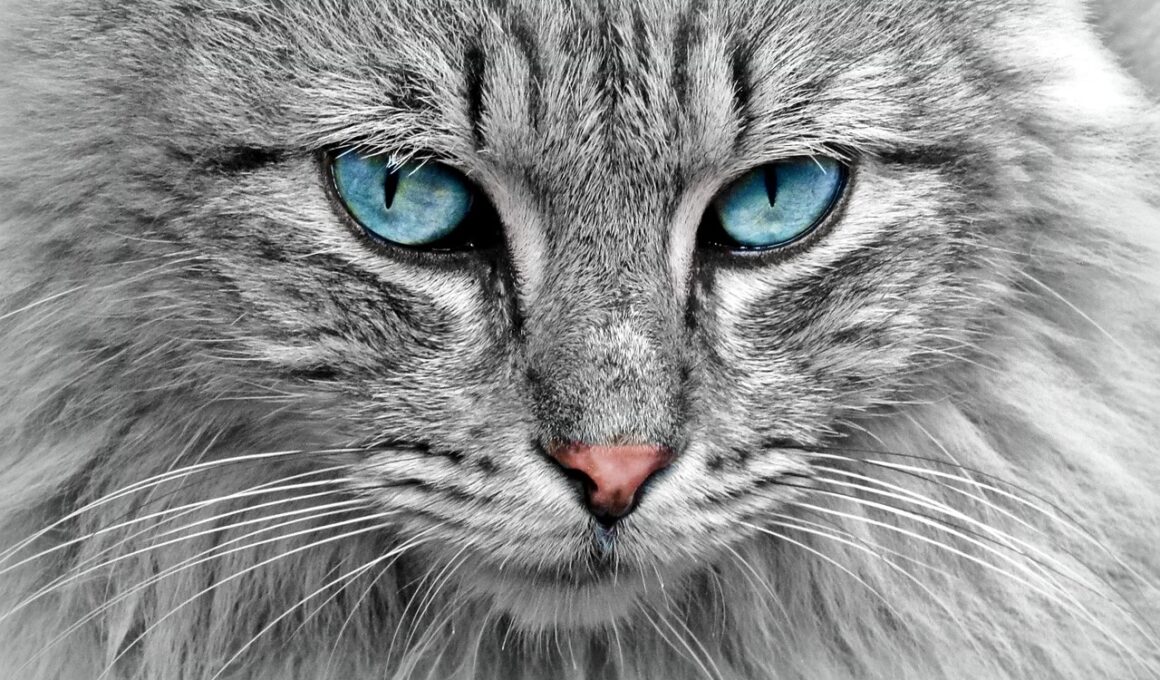How Environmental Enrichment Boosts Cat Social Skills
Understanding cat socialization is vital for fostering healthy feline behaviors. Cats, being naturally independent, often navigate social networks differently than dogs. Providing environmental enrichment plays a crucial role in enhancing their interactions. Enrichment can include a variety of stimuli, encouraging cats to engage more with their environment. For instance, offering climbing structures allows cats to survey their surroundings from a height, increasing confidence. Moreover, interactive toys stimulate mental activity, keeping them engaged. Ultimately, fostering a stimulating environment promotes positive social skills through interaction and play. When cats feel secure in their spaces, they are more likely to interact with others. Social skills may include grooming behaviors, vocalizations, and playing with other pets. A cat enriched by its surroundings tends to exhibit less aggression and more curiosity, essential traits for healthy socialization. Furthermore, exposing them to various scents or sounds can help reduce fear responses, facilitating easier integration. Enrichment is not merely for fun, as it significantly impacts their social health and emotional stability.
In addition to physical stimulation, mental enrichment is critical for cat socialization. Brain activities, like puzzle feeders or scent trails, keep a cat’s mind sharp. When engaged mentally, cats often become more curious about their companions, whether humans or other pets. Toys that mimic prey behavior can encourage cooperative play, teaching cats to interact in a social context. Group playtime with other cats also strengthens bonds, helping them learn vital communication tactics. Providing socialization opportunities early in life ensures that cats grow up comfortable and confident. For shy cats, gradual introductions to new experiences and companions can reduce anxiety. The more a cat engages socially, the better its overall adaptability in interactive settings. Many owners underestimate the value of active playtime; however, dedicated interactions can shape a cat’s personality for the better. Cats also learn using observational skills, adapting behavior from watching others. Positive reinforcement for desirable behaviors further nurtures social skills, making interactions rewarding for the cat. Building a stimulating environment fosters positive habits through encouragement of healthy social behaviors.
The Role of Play in Social Skills Development
Play emerges as an essential tool in developing cat social skills. When cats engage in play, they mimic predatory behaviors, which can be vital for growing social dynamics. Through playful interaction with their peers, kittens learn the nuances of body language and vocalizations. They also understand boundaries during play, which is crucial in preventing aggression. Furthermore, play encourages creativity in responses, helping cats adapt to various social situations. It serves as a form of communication among cats, establishing trust and camaraderie. Multifunctional playspaces facilitate these interactions, enhancing bonding experiences. Providing toys that require teamwork promotes sharing and cooperation skills. Moreover, it encourages problem-solving among cats, further enhancing social interactions. Ultimately, play should be integrated as a fundamental aspect of a cat’s daily routine. Regular interactions through play can alleviate stress and enhance emotional connections. Cats that lack playtime may face behavioral issues, including aggression or withdrawal. By prioritizing play, owners can ensure healthy social development, paving the path for harmonious living experiences. Socially skilled cats contribute to a satisfying home environment, showcasing their well-adjusted personalities.
Creating a Stimulating Environment
Designing a stimulating environment for cats involves careful consideration of their needs and personalities. Cats thrive in spaces that offer diverse enrichment options, allowing them to explore and play. Areas should include vertically appealing structures, like shelves, to encourage climbing, which many cats find enjoyable and comforting. Engaging items such as feather wands or laser pointers bring energetic play to daily routines, fostering connection with human companions. Moreover, incorporating various textures and surfaces can pique curiosity, leading to exploration. Scented toys and scratching posts can also enhance their engagement levels. These elements create opportunities for natural instinctual behaviors essential for social development. Additionally, providing safe outdoor access through catios can drastically improve their psychological wellbeing. Social exposure becomes more prominent in this safe environment, promoting interactive opportunities with other animals. A peaceful atmosphere reduces stress, making it easier for cats to express their social behaviors. Owners should observe their cats closely to tailor the enriching elements that resonate with their individual preferences. By focusing on individual personalities, the home environment can be transformed into a cat-friendly haven that encourages healthy socialization.
Positive reinforcement methods significantly enhance social interactions. Rewarding desirable behaviors with treats or praise encourages cats to develop their social skills. When cats associate positive outcomes with social interactions, they become more open and engaging towards others. For instance, offering a treat during a successful meet-and-greet builds confidence and reinforces the behavior. This practice can significantly impact timid cats, providing safety in learning social norms. Owners should aim for consistent reinforcement, creating a routine that emphasizes socializing with humans or other animals. The more a cat experiences positive interactions, the better they become at navigating new social scenarios. Moreover, adjustments can be made depending on individual reactions; for example, some cats respond better to gentle encouragement, while others may thrive on enthusiastic praise. Monitoring their reactions is essential in understanding their social needs. Establishing gradual reward systems enhances trust and familiarity, improving long-term social integration. Frequent interaction without pressure helps cats feel secure in new situations. By fostering trust through positive reinforcement, owners can positively shape their cats’ social behaviors. Building a solid foundation results in healthier emotional states and harmonious social lives for cats.
Understanding Feline Body Language
Recognizing feline body language is vital for promoting healthy social skills. Understanding how cats communicate with each other through body language can significantly aid in socialization efforts. Signs of discomfort, such as a flicking tail or flattened ears, indicate when a cat is feeling threatened. Conversely, relaxed postures signal comfort and a willingness to engage socially. This awareness helps pet owners create environments where cats feel secure enough to explore interactions. Educating oneself about feline behavior leads to improved facilitation of positive social experiences. Observing interactions among multiple cats can offer insights into their social structure and hierarchy. Many cat owners unknowingly misinterpret cues, leading to increased anxiety during introductions. Therefore, taking time to study their body language equips owners to better engage and enrich their cats’ lives. Allowing for safe and gradual introductions to new friends also decreases tension. Positive experiences are essential in building a cat’s social confidence. By fostering understanding through observation, relationships develop stronger over time. Cat owners should strive to foster environments where their pets can safely articulate their preferences and needs effectively.
In conclusion, environmental enrichment serves as a crucial factor in enhancing cat social skills. With appropriate stimulation, cats can develop healthy interactions that benefit their emotional wellbeing. Creating spaces that cater to the instinctual behaviors of cats ensures opportunities for play and discovery. The blend of creative exploration and positive reinforcement cultivates a well-rounded approach to socialization. Factors such as play, safe environments, and understanding body language merge harmoniously to promote growth in social skills. An engaging home environment is essential in addressing behavioral issues, making social development more manageable. Timely exposure to varied stimuli encourages adaptability among felines, making them more socially competent. In summary, improving a cat’s social skills leads to better relationships with companions, reducing anxiety levels and enhancing overall happiness. Owners who dedicate resources toward enriching their pets’ environments witness significant advancements in their social behaviors over time. Overall, maintaining a stimulating environment is a rewarding investment in a cat’s overall health and happiness, paving the way for a fulfilling social life.
Striving for the best possible environment ultimately leads to harmonious living conditions for both cats and their humans. Cat owners should embrace the journey of learning and adaptation alongside their beloved pets.


